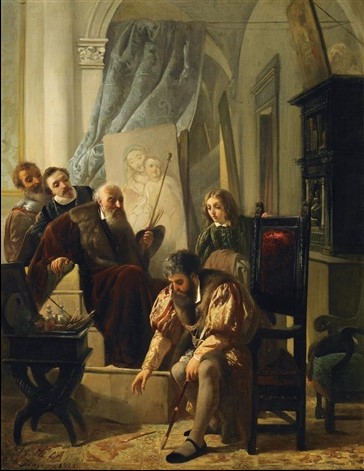The Legend of the Artist - Beat Rink
The Legend of the Artist
by Beat Rink

Annibale Gatti: Emperor Charles V picks up Titian's paintbrush, 1858
Protogenes’ Sponge, Titian’s Paintbrush...
In their book “The Legend of the Artist”, published in 1934, the authors Ernst Kris and Otto Kurz show, with a fascinating plethora of anecdotes, how numerous legends grow up around artists.
Some examples:
The ancient painter Protogenes attempted to depict a dog foaming at the mouth. He could not get it right. Angrily, he threw the sponge at the canvas. And behold: suddenly he had the most perfect depiction of foam.
Or: When visiting Titian’s studio, Emperor Charles V noticed the painter’s paintbrush falling to the ground. He quickly bent down and picked it up.
The painter Hans Holbein, on the other hand, was less polite in his behaviour towards a nobleman: in an argument, he threw a Count, who wanted to gain access to the studio and, above all, to the woman who was sitting as a model, down the stairs. The King, when he heard of this, defended Holbein with these words: “In one day I can make Counts out of seven peasants, but cannot make a single Holbein out of seven Counts.”
What do these stories have in common?
They are all constituents of ideas and images of artists and art that have been existed for centuries and are passed on from generation to generation. In all the examples given, the theme is that there is something “special” that surrounds the artist and his work: even chance helps with the work. And the artist is placed above secular authority and is even admired by King and Emperor.
What Kris and Otto show us is a little different: the image of the artist becomes so dominant in some cases that the artists take their orientation from it and lead their lives accordingly. Michelangelo was the first to be called “Il Divino” [“The Divine”]. Since then, the attribute “divine” has being used above all for prima donnas – and this is how the “Diva” came into being: a leading lady who not only sings divinely, but also behaves like a goddess.
Our whole culture is permeated by images and ideas of what artists are and how they must be. And that leads to this question: How do these images influence our activity and life as artists? Do they spur us on? – Good! Are they a burden and a straitjacket? – Bad! The experience of many artists is that images projected onto them by others limit them and inhibit them in their development – and that this imprint leaves its traces throughout their lives.
To demonstrate this with another example: Some great art originates in moments of despair and when life is in disorder. So the artist who wants to create something great imagines “I cannot be happy and light-hearted. My life should be less orderly!”
A curious error
An experience last week was almost like a parable for me, as I opened up a sociological book I had ordered by post. It had the title “The Modern Artist”. Full of expectation, I wanted to get started. But there was something completely different inside it. Strange: the title and the contents did not match at all! A curious error during printing, as the publisher explained in reply to my enquiry. In so many cases, the title “modern artist” does not match the real content of our lives. In so many cases, we feel we have to live up to a “legend of an artist” and thus fulfill the strange expectations of others. This then creates compulsions and inhibits creativity. But we are called to become what God has created and called us to be!
How do we become free?
A starting point could be acting on Romans 12,2, where we read: “Do not conform any longer to the pattern of this world, but be transformed by the renewing of your mind. Then you will be able to test and approve what God’s will is – His good, pleasing and perfect will.”
Paul recommends to us that we reflect on the world (including images projected on us by others) and that we find a new way of thinking oriented on God and His will. Let us reflect on what God wants to give us and let us be changed by that (which is ultimately only possible with the help of the Only Spirit), and then the old images will lose their power more and more. We, conversely, gain freedom and a consciousness, given by God, of our individual calling. And also new joy in being an artist!
Perhaps we could write down on a piece of paper the images of an artist which still influence us negatively, and what we can do against this in the sense of Romans 12,2.
***
Translation: Bill Buchanan
The TUNE INs are weekly spiritual reflections for artists, published by Crescendo. Feel to forward them to other artists or let them know that they can order them (for free) via info@crescendo.org. The TUNE INs are also on Facebook > Click the F-Icon You are also welcome to leave there a comment!


